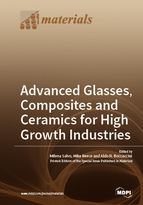Advanced Glasses, Composites and Ceramics for High Growth Industries
A special issue of Materials (ISSN 1996-1944).
Deadline for manuscript submissions: closed (31 December 2018) | Viewed by 56432
Special Issue Editors
Interests: joining of advanced materials; ceramics; glasses; ceramic matrix composites; oxidation protective coatings; reuse of bottom-ash
Interests: field assisted processing; ultra high temperature ceramics; high entropy materials; ferroelectric polymers
Interests: bioactive glasses; bioceramics; composite coatings; biofabrication; scaffolds; tissue engineering
Special Issues, Collections and Topics in MDPI journals
Special Issue Information
Dear Colleagues,
“Advanced glasses, Composites And Ceramics for High growth Industries” (CoACH) is a European Training Network (ETN) (http://www.coach-etn.eu/) funded by the Horizon 2020 program. The project is studying the next generation of materials that could bring innovation in the healthcare, construction, energy and other sectors. From new bioactive glasses for bone implants to eco-friendly cements and new environmentally friendly thermoelectrics for energy conversion, the novel materials developed in CoACH pave the way for innovative products, improved cost competitiveness and positive environmental impact. The broad range of research activities conducted within the framework of CoACH includes (i) new antibacterial glasses and hybrid coatings; (ii) energy efficient, low-cost and eco-friendly cement and insulation materials produced from industrial wastes; (ii) innovative materials for energy production and harvesting and (iv) sensors and polymer composites used in harsh environments. The present Special Issue will contain papers resulting from the CoACH project, showcasing the breadth of materials and processes developed during the project.
Prof. Milena Salvo
Prof. Mike Reece
Prof. Aldo R. Boccaccini
Guest Editors
Manuscript Submission Information
Manuscripts should be submitted online at www.mdpi.com by registering and logging in to this website. Once you are registered, click here to go to the submission form. Manuscripts can be submitted until the deadline. All submissions that pass pre-check are peer-reviewed. Accepted papers will be published continuously in the journal (as soon as accepted) and will be listed together on the special issue website. Research articles, review articles as well as short communications are invited. For planned papers, a title and short abstract (about 100 words) can be sent to the Editorial Office for announcement on this website.
Submitted manuscripts should not have been published previously, nor be under consideration for publication elsewhere (except conference proceedings papers). All manuscripts are thoroughly refereed through a single-blind peer-review process. A guide for authors and other relevant information for submission of manuscripts is available on the Instructions for Authors page. Materials is an international peer-reviewed open access semimonthly journal published by MDPI.
Please visit the Instructions for Authors page before submitting a manuscript. The Article Processing Charge (APC) for publication in this open access journal is 2600 CHF (Swiss Francs). Submitted papers should be well formatted and use good English. Authors may use MDPI's English editing service prior to publication or during author revisions.
Keywords
- Glasses
- Composites
- Bioactive glasses
- Antibacterial materials
- Coatings
- Geopolymers
- Glass-ceramics
- Cements
- Thermoelectrics
- Field assisted processing
- Sensors









